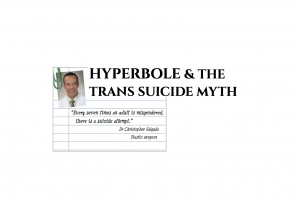
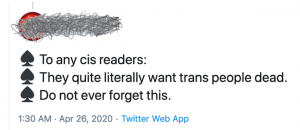 It is incredibly difficult to approach the subject of suicide among trans-identified people without being labelled a hateful bigot who wants trans kids to kill themselves.
It is incredibly difficult to approach the subject of suicide among trans-identified people without being labelled a hateful bigot who wants trans kids to kill themselves.
Yet one of the main concerns voiced by those who question the suicide myth is that trans-identified children are being fed the lie that if they are ‘truly trans’ there’s a 50/50 chance they will at least attempt suicide. This is a dangerous message to feed an already vulnerable population.
“The suicide rates have been misconstrued. And constant references to trans kids committing suicide will likely fuel suicide contagion.”
Lisa Marchiano, writer & Jungian Analyst

Who is at risk of suicide?
In the UK, the ONS reports that men are three times as vulnerable to death from suicide as women. Divorced men are three times more likely to take their own lives as married men. People among the most deprived 10% of society are more than twice as likely to die from suicide than the least deprived 10%. Carers, low-skiller workers and those who work in the arts have a higher risk of suicide than those in other jobs. Female nurses, nursery and primary school teachers are also at risk. Young people who are bullied, using drugs or alcohol to self-medicate and those who have been through trauma are also at high risk. VeryWell Mind reports that one study showed that patients with anorexia were 18 times more likely to die by suicide than in a comparison group.
In America, the Surgeon General reports that suicide among Native American and Alaska Native youth is three times higher than in American youth overall. Individuals in Justice and Child Welfare Settings, for example prisons and child care homes, are three times more likely to take their own lives. One in three detained youth have attempted suicide. The suicide rate among patients with bipolar disorders is estimated to be more than 25 times higher than the rate in the general population, with 15/19% dying by suicide.
Bereavement is a common factor in the suicide of young people under the age of 25. A study in Manchester, England (2107) ‘Suicide by children and young people. National Confidential Inquiry into Suicide and Homicide by People with Mental Illness‘ suggested bereavement was a factor in over 25% of cases. The same study reports that of 922 suicides by people aged under 25 in England and Wales during 2014 and 2015, “6% of under 20s and 3% of 20-24 year olds were reported to be LGBT or uncertain of their sexuality, equivalent to 18 deaths per year”. (This, of course, does not include possible suicides among young people who were not ‘out’ as LGBT.)
Is society constantly reminding certain ethnic minorities, young people in prison, children in care, bereaved young people, and those with eating disorders and other mental illnesses of their high risk of suicide? Does the media constantly report on it, reminding those minority groups at every turn of the potential fate that could await them? No.
Appendix D to the Report of the U.S. Surgeon General and of the National Action Alliance for Suicide Prevention acknowledges the very real ‘cultural and social prejudice’ facing LGBT young people, adding:
“An additional risk factor is resulting from media coverage of LGBT suicide deaths that presents suicidal behavior as a normal, rational response to anti-LGBT bullying or other experiences of discrimination.”
GenderHQ reports:
“Having acknowledged suicide risk in trans people and the increase of it without supportive loved ones, it is necessary to discuss the politicization of suicide and its constant use to silence any debate around the safety of transitioning young people… furthermore, there is a need to examine the ethics of mental health professionals, doctors, trans activists, LGBT orgs and media who tell parents their child will kill themselves if they don’t adhere to immediate affirmation.”
Samaritans media guidelines state: “research shows links between media coverage of suicide and increases in suicidal behaviour… there is no simple explanation for why someone chooses to die by suicide and it is rarely due to one particular factor… Young people are particularly vulnerable to imitational suicides. Research shows they are the group most likely to be influenced by the media.”
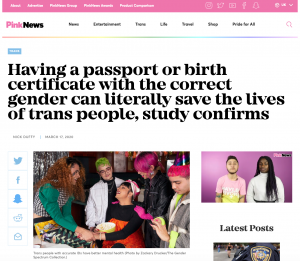
Yet media outlets jump on the idea of trans suicide in a way that they do not do with any other demographic, reporting over and again random statistics on suicide among trans kids, repeatedly quoting the mantra “I’d rather have a live son than a dead daughter,” making wild and unsubstantiated claims about suicide risks and insisting that anyone who questions the claims ‘literally’ wants trans-identified people to die.
“Every seven times an adult is misgendered, there is a suicide attempt.”
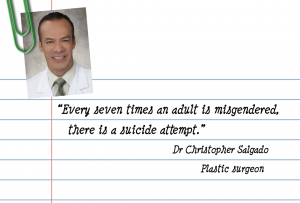
In July 2018, in an interview given in the ‘Health and Fitness’ section of the Miami Herald, entitled ‘Suicide risk high for kids struggling with gender identity: these people can help’, Dr Christopher Salgado told journalist Emily Himes:
“Every seven times an adult is misgendered, there is a suicide attempt.”
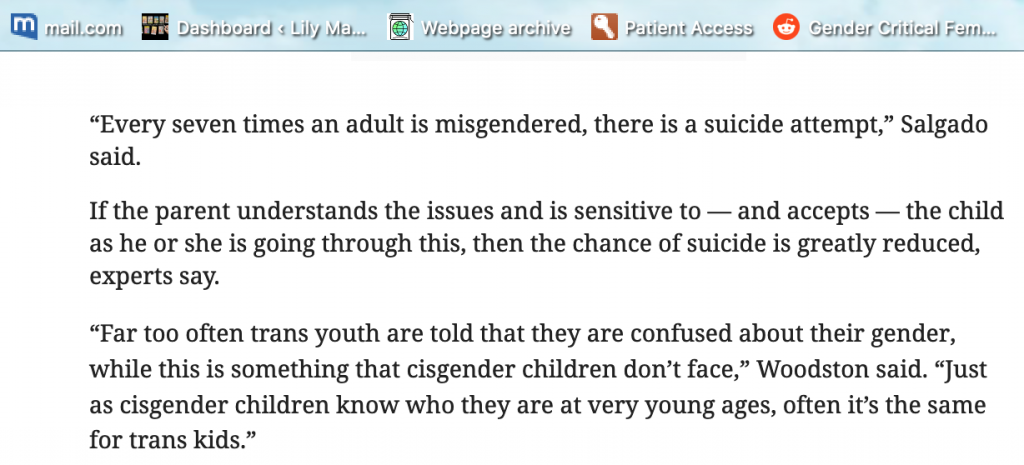
Salgado’s astonishing claim
Of course, it would be completely impossible to gather such data.

Yet the Herald reported Salgado’s words without question. Such is the power of the suicide myth.
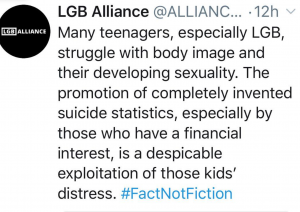
In March 2019, The New York Times reported that Salgado had resigned from his position at the University of Miami in 2018, in controversy over ‘graphic images and mocking captions‘ that he posted on his now-deleted Instagram account and in Facebook groups.
In one photo, reported Transadvocate, he posed a patient’s dissected penis into the shape of a heart and added the hashtag #whatthefuckisthat. In an astonishing act of cruelty, he also referred indirectly to a phalloplasty patient as an ‘implant cripple’.
I decided against including the link to the photos. They can’t be unseen.
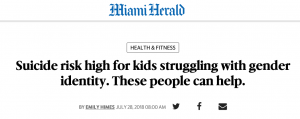 Returning to his 2017 interview in the Miami Herald, Salgado reported, “before, 10 percent of our patients were children under the age of 16. Now we see about 30 percent under 16… medical transitions at younger ages can prevent trans children from developing secondary sex characteristics that may cause additional dysphoria.”
Returning to his 2017 interview in the Miami Herald, Salgado reported, “before, 10 percent of our patients were children under the age of 16. Now we see about 30 percent under 16… medical transitions at younger ages can prevent trans children from developing secondary sex characteristics that may cause additional dysphoria.”
Just a recap – this man worked as a surgeon for UHealth where, the article tells us, teenagers can ‘usually’ get top surgery around age 16 and bottom surgery at 18. What possible reason could Salgado have for perpetuating such a myth?
In the light of the circumstances surrounding his resignation, was his quote, recorded in all seriousness by journalist Emily Himes, some sort of sick joke?
How high?
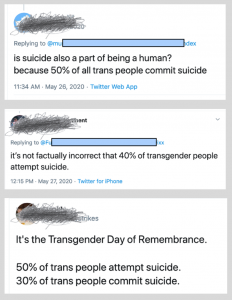
The percentage of trans-identified people that commit suicide is often reported as 30, 40 or even 50%.
There is no evidence to suggest that this is the case.
A brief analysis of the inadequacies of the 2014 Williams Institute study in the USA, ‘The 41% trans suicide attempt rate: A tale of flawed data and lazy journalists’ is available here.
The ‘48% of all trans youth attempt suicide’ statistic is most frequently based on two self-report studies in the UK.
In the much-quoted RaRE study, 2,000 LGBT young people took part. Just 27 were trans-identified, and of these, 13 said they had attempted suicide in the past.
The second study, offered to LGBT children in secondary schools, had a larger population, including nearly 600 young people who identified as trans. Participants were not asked for their sex, only for their gender identity, leading Transgender Trend to speculate that “the ‘transgender’ category may just serve to cover up the scale of suicide attempts and self-harm rates of girls and young women.”
For a more thorough analysis of these UK studies, I recommend that you read Transgender Trend’s comprehensive piece ‘Suicide Facts and Myths‘ here.
The problems with self-selection surveys are many: most obviously that happy people are less likely to volunteer to take part in a survey about feeling unhappy. Secondly, we don’t know what other issues participants had. Had they recently lost a loved one? Were they gay or straight? Bipolar? Depressed? Taking drugs? Had they transitioned already or not?
Nuno Nodin, a primary researcher on the study, wrote in an email to Nicola Williams, “It is indeed unfortunate that the findings from the RaRE study have been misrepresented.”
In 2017 the NHS Gender Identity Development Service (GIDS) website reported: “suicide is extremely rare, with one case in the service in the last decade, of a young person in an inpatient ward who was referred with severe psychiatric difficulties.”
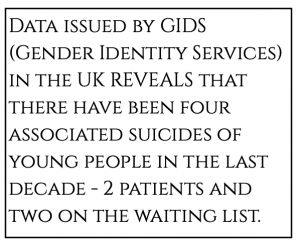 Michael Biggs, Associate Professor of Sociology at the University of Oxford, reports having submitted a Freedom of Information request to GIDS, who replied reporting that there had been three suicides in 2016-17, one of a patient and two of patients on their waiting list.
Michael Biggs, Associate Professor of Sociology at the University of Oxford, reports having submitted a Freedom of Information request to GIDS, who replied reporting that there had been three suicides in 2016-17, one of a patient and two of patients on their waiting list.
One suicide in nearly a decade then three in quick succession? Is the endless repetition of the suicide myth beginning to take its toll? Four is four too many deaths, but thankfully it seems to be far from an epidemic.
The section ‘Evidence Base‘ on the GIDS website tells us:
“it is also true that many young people who present to gender services are not necessarily distressed… suicide is extremely rare… the percentages for associated difficulties and self-harm appear to be in line with young people from the LGB population.”
Obviously, not all young trans-identified people are involved with GIDS. Biggs also contacted the National Confidential Inquiry into Suicide and Safety in Mental Health to see if he could get information about trans-identified young people unknow to GIDS who may have taken their own lives. He reports “None of the cases were identified as transgender.”
You can read Biggs’ guest post, ‘Suicide by trans-identified children in England and Wales’ on the Transgender Trend website, here.
This is not conclusive, of course. Some suicides may not have revealed their trans feelings to anyone. There are certainly a few frequently referenced cases involving the tragic suicides of trans-identified young people, for example Leelah Alcorn’s death in the USA in 2014, and Kyler Precott in the UK in 2015. The fact that those cases are so well known emphasises the rarity of such deaths.
In his article ‘Attempted suicide by American LGBT adolescents’, Biggs suggests that previous evidence on suicide attempts among trans-identified youth has been ‘methodologically flawed’.
“Asking respondents whether they have ever attempted suicide will elicit an overestimate of the actual rate; we know from other studies that more probing questions are needed to distinguish genuine attempts to end life. Therefore we should interpret ‘attempted suicide’ broadly, to include all self-harming behaviors, including those not intended to result in death.”
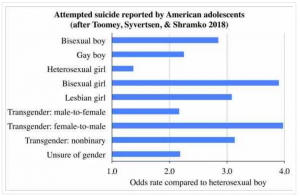 Biggs’ analysis of Toomey, Syvertsen, and Shramko’s 2018 article in Pediatrics concludes:
Biggs’ analysis of Toomey, Syvertsen, and Shramko’s 2018 article in Pediatrics concludes:
“gender-nonconforming girls are the most vulnerable (to suicide attempts) whether they consider themselves to be transgender, bisexual, or lesbian.”
Bisexual girls in the study reported only slightly lower levels of suicide attempts than trans-identified girls (transgender female-to-male).
This important interpretation of data challenges current presumptions and should raise grave concerns. The fact that discussions surrounding this issue are shot down with hyperbole and accusations of hatred is a silencing tactic that should not be allowed to prevail.
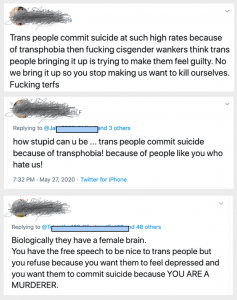 At what point did “You must let trans kids transition or they’ll kill themselves?” become accepted as fact?
At what point did “You must let trans kids transition or they’ll kill themselves?” become accepted as fact?
Where is the proof that child transition lessens suicide ideation and attempts in the long run?
What harm is being done to the trans-identified young people that are being fed this line?
These are questions we are not encouraged to ask. Asking them takes courage, for not only are we told that trans-identified children frequently kill themselves, but that it is all the fault of ‘bigoted’ transphobes and TERFs. Trans-identified children are being encouraged to believe that those who do question this narrative literally want them dead.

“Trust me, I’m a doctor.”
Dr Johanna Olsen-Kennedy
 “We often ask parents, Would you rather have a dead son than a live daughter?” reports Johanna Olsen from the Transgender Youth Clinic in Los Angeles.
“We often ask parents, Would you rather have a dead son than a live daughter?” reports Johanna Olsen from the Transgender Youth Clinic in Los Angeles.
Dr Diane Ehrensaft
 Diane Ehrensaft infamously believes that babies can indicate their trans identities by pulling out their hairslides and unsnapping their babygros. Of child transition, she says,“why would we deny for the vast majority of kids something that is basically suicide prevention?”
Diane Ehrensaft infamously believes that babies can indicate their trans identities by pulling out their hairslides and unsnapping their babygros. Of child transition, she says,“why would we deny for the vast majority of kids something that is basically suicide prevention?”
When confronted by this supposed option for their child – transition or suicide- from a doctor who is ostensibly an expert in their field, I wonder what real choice parents feel they have? And having once made that decision how hard must it be to consider the possibility that there might be an alternative?
Drs Helen & Mike Webberley
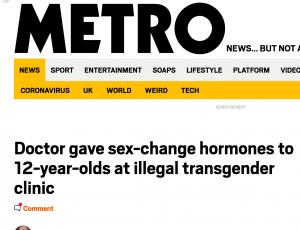 “Dr Helen Webberley” reported the METRO in 2019, “ran a private transgender clinic from her (UK) home to treat children wanting to swap sexes. She offered advice online under the name Gender GP and charged between £75 and £150 an hour.”
“Dr Helen Webberley” reported the METRO in 2019, “ran a private transgender clinic from her (UK) home to treat children wanting to swap sexes. She offered advice online under the name Gender GP and charged between £75 and £150 an hour.”
Webberley provided children as young as 12 with cross-sex hormones from a business that was not registered. She was fined a total of £25,000 for operating without a licence.
On her ‘GenderGP’ website, Webberley refers to her patients as “a marginalised group of people at high risk of suicide.”
Here she is on Twitter.
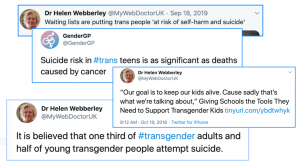
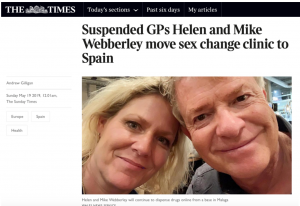 Helen’s husband, Michael, was suspended “after the Medical Practitioners Tribunal Service heard his work for three young trans patients fell below the standards of care expected of a registered doctor, and (he) is currently banned from working in the UK.” reported the Times newspaper in May 2019.
Helen’s husband, Michael, was suspended “after the Medical Practitioners Tribunal Service heard his work for three young trans patients fell below the standards of care expected of a registered doctor, and (he) is currently banned from working in the UK.” reported the Times newspaper in May 2019.
A spokeswoman from the General Medical Council said: “Dr Helen Webberley and Dr Michael Webberley are both interim suspended while the GMC investigates.”

The Times reported that the couple were now running their online business from Malaga, Spain.
It is not so surprising that many parents who have enabled their child’s medical transition are such fierce advocates for child transition and perpetrators of the suicide myth.
Activist mums
“I always say I’d rather have a live daughter than a dead son.” says Jeanette Jennings.
Jeanette is celebrity mother to YouTuber and reality show star Jazz, who underwent a vaginoplasty in 2018, aged 18. Jazz’s ‘wild surgery journey’, which was fraught with complications, was followed by a TV crew and broadcast on TLC network television in America.

The trailer for Jazz’s ‘operation’ episode on TLC Network Television & Jazz, all smiles, recovers afterwards with teddy.
“I have my daughter, whole and alive, but if I had refused to listen then it’s very likely that I would have a dead son.” says Susie Green.
Susie is now CEO of Mermaids and mother of Jackie who underwent a vaginoplasty in 2009, aged 16.
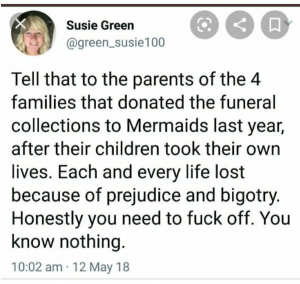 In 2018 Green posted on Twitter that in the previous year four families had donated the funeral collections to Mermaids after their children took their own lives, suggesting that Mermaids had been involved with at least four trans-identifed children who had died by suicide.
In 2018 Green posted on Twitter that in the previous year four families had donated the funeral collections to Mermaids after their children took their own lives, suggesting that Mermaids had been involved with at least four trans-identifed children who had died by suicide.
Another parent claimed, in the same year, ‘Just as an FYI I know of two trans teenage suicides this week alone.‘
Mermaids
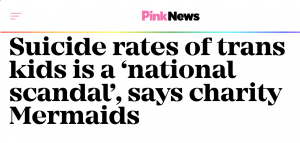
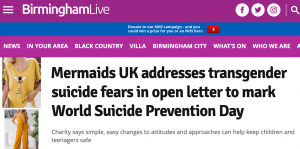 Mermaids’ open letter on National Suicide Prevention Day 2019 begins by reminding the reader that “research from the charity Stonewall shows that nearly half of young trans people have attempted suicide.”
Mermaids’ open letter on National Suicide Prevention Day 2019 begins by reminding the reader that “research from the charity Stonewall shows that nearly half of young trans people have attempted suicide.”
The letter goes on to make the surprising claim that “studies show that, just by using a transgender person’s correct name and pronouns, their anxiety, depression and suicidal thoughts reduce to almost the same as their cisgender counterparts.”
The single self-report study (not studies) cited by Mermaids consisted of 74 trans-identified young people who had changed their name, or wished to do so. I could not find anything that suggested these mechanisms were as startlingly effective as claimed by Mermaids, nor can I fathom how it would be possible to accurately measure such variables.
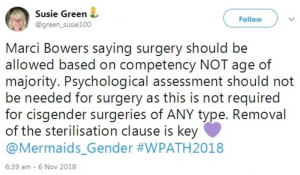 If this really were the case, why would the CEO of Mermaids continue to campaign (see left) for easier and earlier access to medication and surgeries for trans-identified youth?
If this really were the case, why would the CEO of Mermaids continue to campaign (see left) for easier and earlier access to medication and surgeries for trans-identified youth?
Just a few days ago, Mermaids appointed a new trustee, Bobbi Pickard, who started transitioning just three years ago at the age of 47, and has fathered two children. Perhaps someone who started transitioning so late in life will bring a fresh perspective to things? Well… er… no.

“All you need to know,” Bobbi’s website tells us, “is that almost 50% of transgender children attempt suicide and almost all of them have a miserable, tough and lonely time.”
So there you have it. All you need to know indeed.
“Any risk of suicide is terrifying for parents,” observes Transgender Trend. “Every suicide is an awful tragedy and for this reason we feel that exaggerating the risk and constantly using the threat of suicide is extremely unhelpful and irresponsible.”
“Hey, what are you reading?”
 ‘Representing the Rainbow in Young Adult Literature’ (Jenkins & Cart) reviews the young adult fiction book ‘Lily and Dunkin’, an Amazon best book of 2016, and Southern Book Award Winner 2017. The book is aimed at 5-7th graders (that’s kids aged 10-12 to us Brits) and tells the story of Tim, who ‘knows’ that he is really a girl called Lily. The review tells us:
‘Representing the Rainbow in Young Adult Literature’ (Jenkins & Cart) reviews the young adult fiction book ‘Lily and Dunkin’, an Amazon best book of 2016, and Southern Book Award Winner 2017. The book is aimed at 5-7th graders (that’s kids aged 10-12 to us Brits) and tells the story of Tim, who ‘knows’ that he is really a girl called Lily. The review tells us:
“Her real problem is the imperative need to start taking hormone blockers to avoid entering… puberty. Nevertheless her father refuses to accept and approve this… When Lily’s father abruptly changes his mind about Lily’s transition… we learn that the psychologist has told Lily’s father the statistics for transgender kids suicides and attempted suicides. “Would you rather have a dead son or a live daughter?” she asks…’
At the book’s end Lily/Tim’s previously disapproving father is at the school dance, ‘proudly wearing an ‘I Love my daughter’ shirt.’
“Hey, what are you watching?”
I am Leo
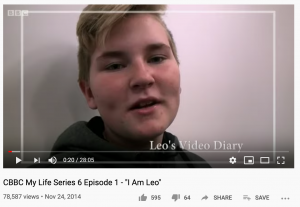 The CBBC (children’s BBC) documentary ‘I am Leo’ follows the transition of Lily, who changed her name to Leo at the age of eleven and started hormone blockers at the age of 12.
The CBBC (children’s BBC) documentary ‘I am Leo’ follows the transition of Lily, who changed her name to Leo at the age of eleven and started hormone blockers at the age of 12.
“Leo loves socialising with his friends, beat-boxing and doing all the things a 13 year-old boy would normally do. What makes Leo different is that he was born with a girl’s body.” gushes the BBC website.
When Helen Saxby wrote to the BBC pointing out, among other things, that ‘the role of online political trans activism in the creation of this story is not examined,’ she was told in a reply:
‘Statistics repeatedly show that because of this lack of understanding and education, transgender children… are more likely to self-harm and take their own lives.’
“I would probably kill myself” was Leo’s response in a Daily Mail article, when asked what the result of being ‘forced to live as a girl’ would have been.
In the same article, Susie Green is quoted as saying “The self-harm and suicide rate among transgender teens is extremely high so offering blockers saves lives. It’s quite simple.”
A year later, she told the Guardian “If they feel their body is changing against their will, that’s when we get a lot of suicidality, self-harm, lots of young people talking about wanting to be dead.”
“The threat of suicide is one that is constantly used to guilt-trip parents who are not 100% on board with the trans narrative, but there is speculation as to the cause of self-harm and suicidal behaviour, rather than hard stats,” observes Saxby.
Butterfly

Max from ‘Butterfly’ on the hospital trolley.
The 2018 television series ‘Butterfly’, based loosely on the story of Susie and Jackie Green, also exploits the suicide myth: a side effect of young Max’s suicide attempt is that his father moves back into the family home. Rushed through the hospital, Max lies like a modern day Ophelia, hair lightly curled, impeccable and perfectly made up, on a hospital trolley. (I write more about ‘Butterfly’ here.)
“I want a happy daughter, not a dead son,” says mum Vicky.
When the gender clinic don’t immediately offer Max blockers, Vicky asks them what they plan to do instead. “Offer more counselling when she tries to commit suicide again?”
When his mother takes him to Boston without his father’s permission, Max speaks to the police, explaining ominously that she did it because, “she doesn’t want me to get suicidal again.”
After ‘Butterfly’ aired on BBC TV, GIDS released this statement:
“Suicidality in young people attending the GIDS is similar to that of young people referred to child and adolescent mental health services. It is not helpful to suggest that suicidality is an inevitable part of this condition.”
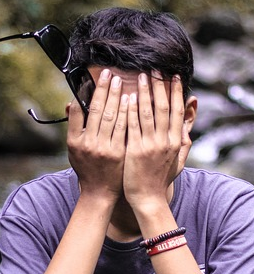
facepalm indeed
Despite this information being freely accessible, the Gendered Intelligence/Tate teachers’ resource “I want to show you a Body” tells teachers, “there is an extremely high rate of suicide amongst transgender children in schools.”
Who are the ‘bad guys’? (Clue, they’re almost always women)
Liz Truss, Minister for Women and Equalities
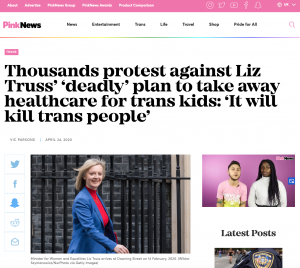
Pink News recently made the claim that “Liz Truss’ move to restrict healthcare access for trans young people is one of the most damaging policy moves for trans rights in the UK in recent memory.”
What, you may well ask, had the Minister for Equalities said to provoke such outrage?
Truss had highlighted the importance of ensuring trans-identified children are protected from making irreversible decisions before their decision-making capacity is fully formed. Expressly:
“…making sure that the under-18s are protected from decisions that they could make, that are irreversible in the future. I believe strongly that adults should have the freedom to lead their lives as they see fit, but I think it’s very important that while people are still developing their decision-making capabilities that we protect them from making those irreversible decisions.”
The Minister for Equalities wants to protect children against making irreversible decisions. Is this unreasonable?
“We’re concerned about comments that relate to protecting trans people who are under 18 from making ‘irreversible decisions” warned Laura Russell of Stonewall in the Independent.
A seventeen year old child isn’t considered old enough, under UK to law, to purchase a bottle of WKD and a packet of cigarettes and sit back and watch ‘Pulp Fiction’. These days a seventeen year old child isn’t considered old enough to leave school for fuck’s sake! Why would we not want to have laws protecting disturbed children from irreversible drugs and cutting off healthy body parts?
Twitter users – including an MP- immediately rolled out the suicide myth.
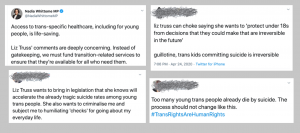
In the light of Truss’ statement, a petition has been started which speaks of ‘conquoring transphobic individuals’ and advocates for both hormone treatments and surgeries for under-age children.
At the time of writing, an astonishing 45,000 people have signed the petition. Did they read what they were signing? Do they really understand what this means? Do they really support the removal of young girls’ breasts and cutting off boys’ penises?
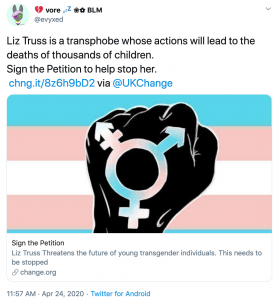
A twitter user links to the petition
Comments on the petition include:
“trans youth are going to die because of this. The suicide rate is already so high because of the appalling waiting times and rise of transphobia within the UK, and this will only add fuel to the fire…
I am the parent of a child whose very life would be threatened by this...
if rights are pushed any further back it will be disastrous for the mental health and safety of trans kids...
young trans people are already at a high risk of dying from suicide, removing the little support they have through the NHS will result in more deaths… these changes would be incredibly harmful for young trans youth.
“I’m transgender ftm myself and under 18. This is actively taking away my right to health care and putting my own life in danger”
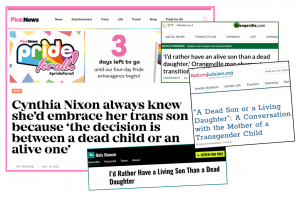
While the media plays its role in perpetuating the myth, once the idea is planted young people themselves- understandably- seem to run with it.
“… for already vulnerable adolescents, technology can provide a forum for more trauma, worsening conflict or isolation. Further, having easy access to information on the internet about how to engage in self-harm can be dangerous for teens with mental health concerns.” reported Stephanie Doupnik, pediatrician at the Children’s Hospital of Philadelphia, in 2019.
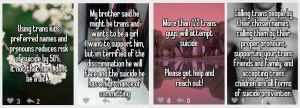
Young people on ‘Whisper’ perpetuating the suicide myth.
If we repeatedly tell young people that they are a vulnerable population, likely to kill themselves, and that suicide is a viable solution to their problems, we cannot be surprised if they start to believe it. We can only hope we don’t end up with a self-fulfilling prophecy on our hands.
JK Rowling, author
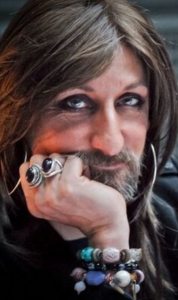 Since tweeting support for Maya ‘it is impossible to change sex’ Forstater, and ‘liking’ a tweet from Fred Sargeant calling Alex Drummond (left) a man, J K Rowling has been besieged with attacks from transactivists calling her transphobic and hateful.
Since tweeting support for Maya ‘it is impossible to change sex’ Forstater, and ‘liking’ a tweet from Fred Sargeant calling Alex Drummond (left) a man, J K Rowling has been besieged with attacks from transactivists calling her transphobic and hateful.
Yesterday (29/5/20) Canadian transactivist Nicole Spurling tweeted: “Definitely something to keep a close eye on. In recent years, Rowling has made it clear that she can no longer be trusted around children.”
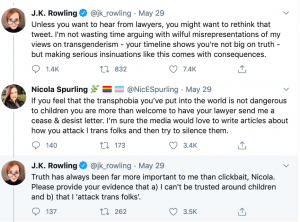
Rowling hit back, inferring legal action, and Spurling withdrew the tweet, but not before invoking the suicide myth.
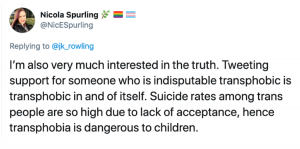
Spurling was not alone in making this giant leap.
“We said she was unsafe around children because she promotes the idea that some of them are not valid, potentially contributing to suicide rates.” commented one Twitter user.

To precis, this way of thinking believes that tweeting support for a woman who says it’s not possible to change sex means that you are directly responsible for the suicides of trans-identified children.
“Mental health problems, including suicide, are associated with some forms of gender dysphoria. But suicide is rare even among gender dysphoric persons.There is no persuasive evidence that gender transition reduces gender dysphoric children’s likelihood of killing themselves.” Bailey & Blanchard
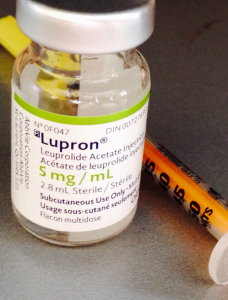 There is no substantial information to suggest the suicide of trans-identified children isn’t incredibly rare.
There is no substantial information to suggest the suicide of trans-identified children isn’t incredibly rare.
There is no substantial information to suggest that giving trans-identified children easy access to puberty blockers, cross-sex hormones and irreversible surgeries will benefit their mental health in the long term.
The hyperbole needs to stop right now, before they start believing that immediate transition or suicide are the only two alternatives available to them; before we really do have an epidemic on our hands.
 If you, or someone you know is at risk of attempting suicide, you can contact the Samaritans here.
If you, or someone you know is at risk of attempting suicide, you can contact the Samaritans here.


Thanks for this. Thing is, if you have a friend or family member who is inclined to self-harm, giving them everything they want is not been a good friend to them.
This is extremely useful as the myth of suicide rates is echoed and re echoed until it becomes a trans truth. Ie not a truth. Thank you for collating this information and presenting it in an accessible manner x
This is a great article, but… Then what is the other option? If someone is extremely dysphoric lifelong, not even just a child, what can we do to alleviate dysphoria? Nothing else really worked for me and I just feel so much for these poor kids. I don’t want people to transition is there is another solution. It seems like there really is nothing yet – I believe that is the emotional drive behind many of these claims alongside the “narrative”. Even desisters struggle with battling dysphoria and I cannot go the lengths to say how it hurts to see no other solution for non-social discomfort like that.
I’m not saying you should know. Nobody knows what the “cure” would be, we don’t know enough in general. And this article is suburb is debunking a lot of BS out there currently. Maybe I’m just ranting. Idk.
adhd jenter
Takk for at du delte en så fantastisk blogg. Jeg synes det er veldig nyttig og lærer mye av det.
Takk skal du ha
Puberty blockers, hormone treatments and irreversible surgeries are indeed NOT for the benefit of those to and on whom it’s being done, nor for their mental health, but rather for the SOLE and EXCLUSIVE benefit of the LGBTQ supremacist “community” which has degenerated and metastasized into what Robert Spencer wrote about Islam: “a political system that is authoritarian, supremacist, discriminatory, expansionist, violent and aggressive.” These things are ALL about spreading such destructive behaviors and increasing the number of these surgically- and otherwise-altered freaks in order to create population and demographic “critical mass” as part of a “strength in numbers” strategy to further destroy the Judeo-Christian bearings of society and replace them with immoral, amoral, depraved, deviant, perverted, radical fringe Greenwich Village/San Francisco/Fire Island “values” of which the promotion and spreading of transgenderism is one key tenet.
Their screaming “transphobia” anytime anyone fights back against this blatant artificiality and nefarious ideology (and yes, “transgender” is ideology, meant to override and supersede the realities of biology) is the same exact strategy as Islamist groups bandying about the term “Islamophobia” to silence anyone who stands against the jihad terror agenda and the Sharia oppression of women and others. In fact, many who support transgenderizing both boys and girls in this way, also support the barbaric Islamic practice of FGM on girls as young as aged 7 – a procedure which likewise is of no benefit to them, but rather further perpetuates Islam and their pernicious doctrine. Initiatives to ban FGM – and restrict any consideration of Sharia law in enacting local laws – have been increasingly shot down as constituting “Islamophobia.” This is the exact same playbook used by LGBTQ supremacists and their enablers and facilitators.
Two things:
1. Aside from all of the other reasons, I can’t help wondering if the sex (as in intercourse)-obsessed culture we live in has something to do with the current rise in dysphoria and “trans kids.”
My daughters did most of their schooling in the UK. Because of the sex-ed program my younger’s school was about to have, I had to sit down with my (then) eleven-year-old daughter and explain to her exactly what sex was, exactly how it happened, exactly how it made babies. (She did do the class at school, but I wanted her to hear it from me first, at home–something for which she was very grateful.) I did all of this using the school’s materials as a guide. My little lecture included showing her the close-up photo of a flaccid penis and testicles that the school provided, which was shown to my daughter and all of her classmates the following week.
At the end of this presentation, my daughter sat, pale and silent, for a long moment. Then she burst into tears. She cried for a long time on my lap, while I assured her that she never had to do it if she didn’t want to but that one day she probably would want to, that it wasn’t as scary as it seemed, that she would be okay, and that I would always be there for her. My poor baby.
I’m not arguing against sex ed in schools, specifically. I do think eleven is a little young to be staring at the penis of a fully grown male (and video of a live birth, which they also watched–a live birth video was traumatizing for me to watch as a married, pregnant adult in birthing class at the hospital; I can’t imagine seeing it as a young girl), and I do think that such programs, whatever good they might do in terms of birth control etc., can send children the message that we expect them to have sex, sooner rather than later.
How many little girls out there, horrified by the thought of that thing being shoved into their bodies, are thinking they would much rather be the ones doing the shoving? How many little boys out there, aware that their penises do not resemble the picture they’ve been shown and frightened of the idea of penetrating another person’s body, are thinking they would much rather be the passive partner in all of this?
In other words, how much of the desire to delay puberty and/or to transition is fear of adult sexuality, the adult sexuality they are clearly expected to develop and participate in at an age when many still sleep with cuddly toys? How much of the “trans kids” fashion is not just about gender roles, but about actual sex roles, and a fear of growing up (I know you touched on the fear of growing up in other articles here)? Many adults, especially (to my knowledge) the gender-n-kink crowd, look back at their adolescence as a time when they were eager to have sex, but for many young people that’s not the case. IMO all this “sex positivity” puts a lot of pressure on children and makes those who are more timid or unsure feel like–surprise–something is wrong with them because they aren’t rarin’ to go. (I don’t think sex is bad, either, or anything to be ashamed of. I just think the emphasis on sex and sexiness, the teaching of explicit materials and things like kink and fisting to preteens, can be off-putting and scary for kids, especially if they’re made to feel that this is expected of them, and expected at any early age. There are few places for them to get away from it, and fewer places that tell them it’s okay not to be sexy and eager for sex, and okay to be scared or uncomfortable at the idea.) If we tell our young girls that the way to be a strong empowered woman is to be a stripper or sleep with lots of strangers, are we surprised when some of them want to be strong men instead? (Don’t even get me started on the “males are horrible beasts and pigs,” or “women are stronger and better than men” messages we give young boys today. It amazes me still that no one seemed to even pause for a moment to think that “Jazz” Jennings is the only boy in a family of girls, and what that might have meant to/for him.) I’m sorry, I’m sure there are some if not many who won’t agree with me there, and I’m not saying I’m right, I’m just throwing some thoughts out there.
Second…Great idea, media and activists. Aside from their weirdo fetish about children’s bodies (and all of their other fetishes, let’s be honest here), let’s not only make kids obsessed with the idea of suicide but teach them that threatening suicide is *the* way to get what they want, and let’s teach parents and other adults that the way to deal with a child threatening suicide is not to seek counseling, not to sit down and explain how things change and get better, but to immediately capitulate to whatever demand the child is making at any given moment.
It amazes and frightens me the way these lies become “truth” even when the actual truth is out there. “Trans kids kill themselves if they can’t transition.” “Transwomen are murdered at much higher rates than women.” “Unarmed black men are murdered by white policemen every minute of every day.” (I know it’s a different subject, but it’s just as much a provable lie as the trans kids stuff.)
If any of these people truly cared about children, they would not be pushing to allow twelve-year-olds to make such life-altering decisions. But they don’t care about children. They care about their pocketbooks and their fetishes, not necessarily in that order.
It’s just depressing.
Thank you for this blog.